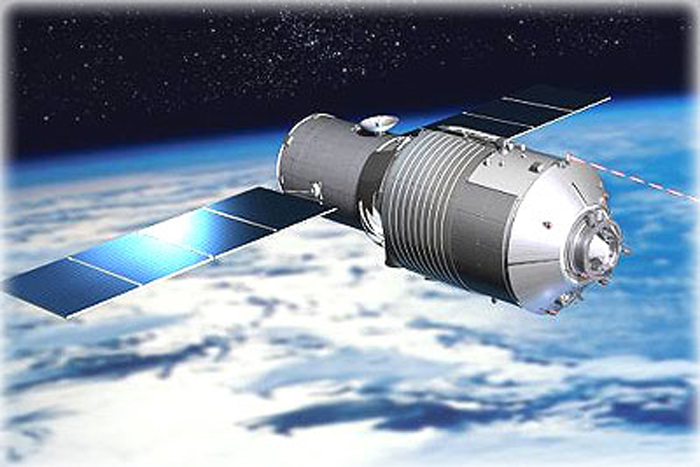
International Campaign Will Monitor Fall of China's Tiangong-1 Space Lab

Skywatchers are on the lookout for China's Tiangong-1 space lab — and the seeing is good.
Tiangong-1 (whose name translates as "heavenly palace") launched into Earth orbit in late September 2011. It was used for six successive rendezvous and dockings with three different spacecraft — Shenzhou-8 (uncrewed), Shenzhou-9 (piloted) and Shenzhou-10 (piloted) — as part of China's human space exploration activities.
But in March 2016, Tiangong-1 ceased functioning. The uncrewed space lab, which weighed 18,740 lbs. (8,500 kilograms) at launch, is now predicted to fall back to Earth in late January 2018, plus or minus one month, according to a forecast generated by researchers at The Aerospace Corporation on Oct. 31. [Gallery: Tiangong 1, China's First Space Laboratory]
"It is unlikely that this is a controlled re-entry," The Aerospace Corporation wrote in a Tiangong-1 re-entry FAQ. "Although not declared officially, it is suspected that control of Tiangong-1 was lost and will not be regained before re-entry."
Based on Tiangong-1's inclination, the lab will re-enter somewhere between 43 degrees north and 43 degrees south latitude, according to the FAQ.
Slow roll
Ground viewing of the Chinese space lab and image analyses suggest that the vehicle shows no sign of tumbling but is apparently in a slow roll.
If that's the case — and remains so when Tiangong-1 nose-dives into the atmosphere — a few pieces of the space lab could conceivably make it all the way to Earth's surface, researchers have said. (Tumbling objects tend to break apart more completely during re-entry.)
Get the Space.com Newsletter
Breaking space news, the latest updates on rocket launches, skywatching events and more!
But don't worry too much about such putative leftovers.
"It is highly unlikely that debris from this re-entry will strike any person or significantly damage any property," The Aerospace Corporation's FAQ stated. "Potentially, there may be a highly toxic and corrosive substance called hydrazine on board the spacecraft that could survive re-entry. For your safety, do not touch any debris you may find on the ground nor inhale vapors it may emit."
The Aerospace Corporation will perform a Tiangong-1 risk calculation for both people and property a few weeks prior to re-entry.
International campaign
An international group known as the Inter-Agency Space Debris Coordination Committee (IADC) will conduct a campaign to monitor Tiangong-1's re-entry.
The IADC comprises experts from 13 organizations, including NASA, the European Space Agency (ESA), European national space agencies and the space agencies of Japan, India, Russia, China and South Korea.
IADC members intend to use the fall of Tiangong-1 to conduct their annual re-entry test campaign, during which participants will pool their predictions of the time window, as well as their respective tracking data sets obtained from radar and other sources.
The aim is to cross-verify, cross-analyze and improve the prediction accuracy for all members.
ESA will serve as host and administrator for the campaign, as it has done for the 20 previous IADC test campaigns since 1998.
Geographic footprint
Holger Krag, head of ESA's Space Debris Office, said China's space-lab re-entry corridor already excludes the possibility that any fragments will fall over any spot above 43 degrees north latitude or below 43 degrees south latitude.
"This means that re-entry may take place over any spot on Earth between these latitudes, which includes several European countries, for example," Krag said.
"The date, time and geographic footprint of the re-entry can only be predicted with large uncertainties," Krag added. "Even shortly before re-entry, only a very large time and geographical window can be estimated."
Owing to Tiangong-1's mass and construction materials, there is a possibility that some portions of the lab will survive and reach the surface, according to an ESA statement.
Leonard David is author of "Mars: Our Future on the Red Planet," published by National Geographic. The book is a companion to the National Geographic Channel series "Mars." A longtime writer for Space.com, David has been reporting on the space industry for more than five decades. Follow us @Spacedotcom, Facebook or Google+. This version of this story was posted on Space.com.
Join our Space Forums to keep talking space on the latest missions, night sky and more! And if you have a news tip, correction or comment, let us know at: community@space.com.

Leonard David is an award-winning space journalist who has been reporting on space activities for more than 50 years. Currently writing as Space.com's Space Insider Columnist among his other projects, Leonard has authored numerous books on space exploration, Mars missions and more, with his latest being "Moon Rush: The New Space Race" published in 2019 by National Geographic. He also wrote "Mars: Our Future on the Red Planet" released in 2016 by National Geographic. Leonard has served as a correspondent for SpaceNews, Scientific American and Aerospace America for the AIAA. He has received many awards, including the first Ordway Award for Sustained Excellence in Spaceflight History in 2015 at the AAS Wernher von Braun Memorial Symposium. You can find out Leonard's latest project at his website and on Twitter.